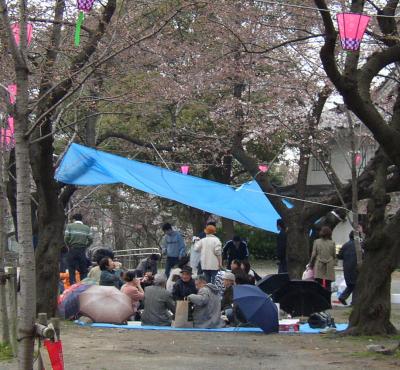
One of the two most important images in all traditional Japanese poetry (the other being the moon). ... Unless some other blossom is specified, in Japan the word blossom or blossoms (hana) will be taken to mean the blossoms of the ornamental cherry ...
from Haiku World, by William J. Higginson
One of the most important events of spring in Japan is 花見 (hanami), or blossom viewing. When I first heard about hanami, I thought it strange that everyone in Japan would go out and spend an afternoon just looking at cherry blossoms. Then, of course, I found out what hanami really is -- a great excuse to party.

These folks are out early, the day after the cherry trees started blossoming. Rain was forecast for the weekend, so this might have been the best time. Given trees in full blossom and a weekend, the whole area would be full of groups like this. Castles, shrines, and parks often have quite a few cherry trees. Groups gather at places known to have cherry trees, stake out some ground, eat, drink and be merry for a few hours.
I love the tradition because there's no formal meaning to it -- no great historical event to remember, no political meaning, no religious meaning, nothing other than getting out with other people and enjoying yourself under some pretty blossoms. It's a national event that's just fun.
Of course, for those inclined to symbolism, the cherry blossom is also associated with the samurai, and often the best place to do hanami is on a castle grounds. Why is such a lovely blossom associated with warriors? After blossoming in the spring, they spend a few days, and then fall all too soon.
Life is short. Enjoy!
No comments:
Post a Comment